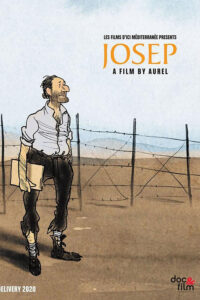Aurel directs, and Jean-Louis Milesi writes “Josep,” a 2020 animated drama/documentary. The award-winning film is about a man reaching the end of his life, recounting his experiences in his youth as an officer at a French concentration camp following the Spanish Civil War. As the only officer who treats the Spanish and Africans with any respect, he befriends Spanish artist Josep Bartolí, who lives in the camps. The film is a true story that looks into a dark part of France’s history not often recounted. “Josep” celebrates an artist’s life while immortalizing those who may have been forgotten in the Francoist Concentration Camps.
“Josep” uses animation as a medium to full potential. The color drains from scenes and returns. Characters fade away to exemplify the words of another character. Characters turn to animals to show their true selves. A man caresses a picture and the picture reacts. At times, Josep Bartolí himself draws the scene. The scene transitions are also fantastical. The film uses a number of match cuts to great effect. It’s magical but it also fits into the world.
The animation allows the audience to experience the magical but deeply dark world Josep has created. The film takes on distinctive styles to differentiate between flashbacks and modern day scenes. In flashbacks, the art style is simple without much movement, akin to a storybook. Viewers quickly realize, however, this is not a children’s book; the film sets its dark tone not just by the art, but also the story. The film uses a dim color palate with muted colors. The background uses buff color, like the pages of an old book. The colors are in effect mood makers.

“Josep” is aided by unpretentious, simple music that suggests otherworldliness; the flashbacks scenes are full works of art that engage the senses. In contrast, once the story is brought to present day, the colors become more lively. Character movements are smoother and the presentation is more like cartoon than storybook. The backgrounds further fill out as well. The room is full of detail giving clues as to who the old man is or was.
Though a cartoon, “Josep” doesn’t shy from showing how the French gendarme acted towards the Spanish during this time. Bling nationalism and a herd mentality result in the same thing in every concentration camp around the world: horrific violence against people for perceived differences. The film shows us this horrific violence alongside Bartolí’s drawings. The drawings serve as a wonderful creative choice; they offer an escape from the horrors of the camps, and a tribute to Josep Bartolí. “Josep” is an inspirational piece that delicately and cleverly presents its subject matter.
3 Comments
Whoa. I really love the way you describe the animation style of this film. Thanks for exploring this “genre,” as I think it’s still criminally underrated.
This was an in- depth review. I’m an art student and I can appreciate the reviewer’s enticing insight and well-informed opinion about this film.
Awww I love Josep. 💘